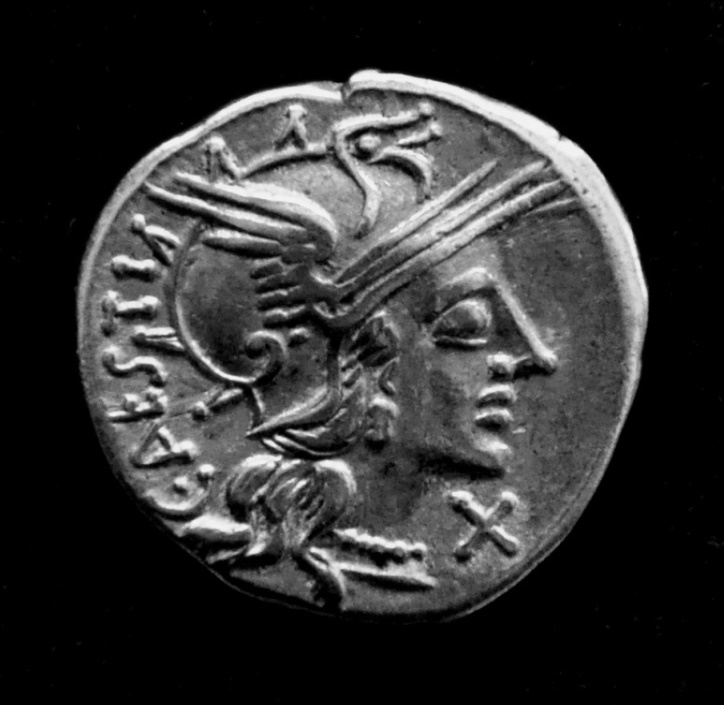In my novel Total War Rome: Destroy Carthage, the Roman general Scipio Africanus stands with his companion Fabius before the walls of Carthage, waiting for the catapults to let fly and for the assault that will change the course of history. The two men cast their minds back to the siege of Intercatia in Spain years before when Scipio had been the first on the walls, winning the coveted corona muralis, and they wonder which of them will be first this time. Here’s an extract from the novel to show what happens next:
Fabius thought for a moment, and then reached into a leather pouch on his belt. ‘Well then, we should toss a coin for it, soldier to soldier.’
Scipio cracked a smile. ‘I should like that.’
Fabius took out a shiny silver denarius, and raised it up. On one side was the head of the goddess Roma, straight-nosed and clear-eyed and wearing a winged helmet, with the name ANTESTIUS along the edge. On the other side was the word ROMA and above it two galloping horsemen with spears, a dog leaping up on its hind legs below them. He handed the coin to Scipio. ‘This is fresh from the mint, given to me by my friend the moneyer Antestius just before I embarked at Ostia. He wanted me to throw it into the ruins of Carthage, in memory of his grandfather who fell at Zama. But I reckon if we toss it and leave it here, that’ll do the trick.’
Scipio turned the coin in his hands. ‘Six hundred and eight years ab urbe condita, in the year of the consulship of Lentulus and Mummius,’ he murmured. ‘I wonder if history will remember this year in that way, or as the year in which Carthage fell?’
The year is 146 BC – six hundred and eight years after the foundation of Rome, by Scipio’s reckoning – and the coin is an actual issue, one of few Roman artefacts that can be dated with confidence to that year. When you open up the book you’ll see it as an image between chapters. On the obverse below the head you can see the Roman numeral X, marking its value as the equivalent of ten bronze asses; this shows that it’s a denarius. The horsemen on the reverse are traditionally thought to represent the gods Castor and Pollux, associated with prowess in war.
At this period of the Roman Republic the moneyers put their own names and symbols on their coins, and here you can see an abbreviated form of Antestius’ name, C.AESTI; he’s known only from his coins, so my allusion to his grandfather is fictional. The little dog, a delightful feature of Antestius’ coins, is thought by some to represent his cognomen – perhaps Catulus, meaning dog – and by others to show his affection for an actual dog, a human touch that makes his coins all the more evocative. The actual coin in this photograph was with me as I wrote the novel, and was a huge inspiration as I contemplated those fateful hours in 146 BC when the future of the ancient world lay in the balance.
Before he tosses the coin we see Scipio raising it to the sunlight, the silver glinting and the walls of Carthage beyond.. Fabius has just told him that Antestius modelled Roma on someone close to Scipio’s heart , and the image of the two horsemen takes him back to the time when he and Fabius had hunted together in the forests of Macedonia with their own dog, when Scipio’s future seemed far from certain. As he thinks of Antestius’ grandfather, of all the men Rome has sacrificed in over a century of bitter conflict with Carthage, he remembers his own single-minded determination to finish the job and heed the senator Cato’s cry, Delenda est Carthago, ‘Carthage must be destroyed’.
There’s a further huge significance to this coin, something that would have preoccupied the real-life Scipio had he looked beyond the coming battle to the army of the future. Antestius is thought to have been the last moneyer to mint the Republican as, the bronze coin that had been the currency standard from the early days. The greater emphasis on the silver denarius may have been a direct consequence of the need to pay the army in bullion coin, at a time when Rome was fighting wars on two fronts – in Greece and in North Africa, culminating in the sieges of Corinth and of Carthage in the same fateful year. In the novel we see Scipio constantly urging for army reform, for Rome to take the crucial step from the citizen levies who had fought her wars in the past to making the legions permanent, exploiting the experience of veteran centurions such as Fabius. As well as everything else, that coin symbolises the coming professionalism of the legions, and what any general knows is the lifeblood of an army – its pay.
The extract is from Total War Rome: Destroy Carthage by David Gibbins
Copyright © 2013 David Gibbins
First published in 2013 in Great Britain by PAN MACMILLAN and in the US by ST. MARTIN’S PRESS/THOMAS DUNNE BOOKS


